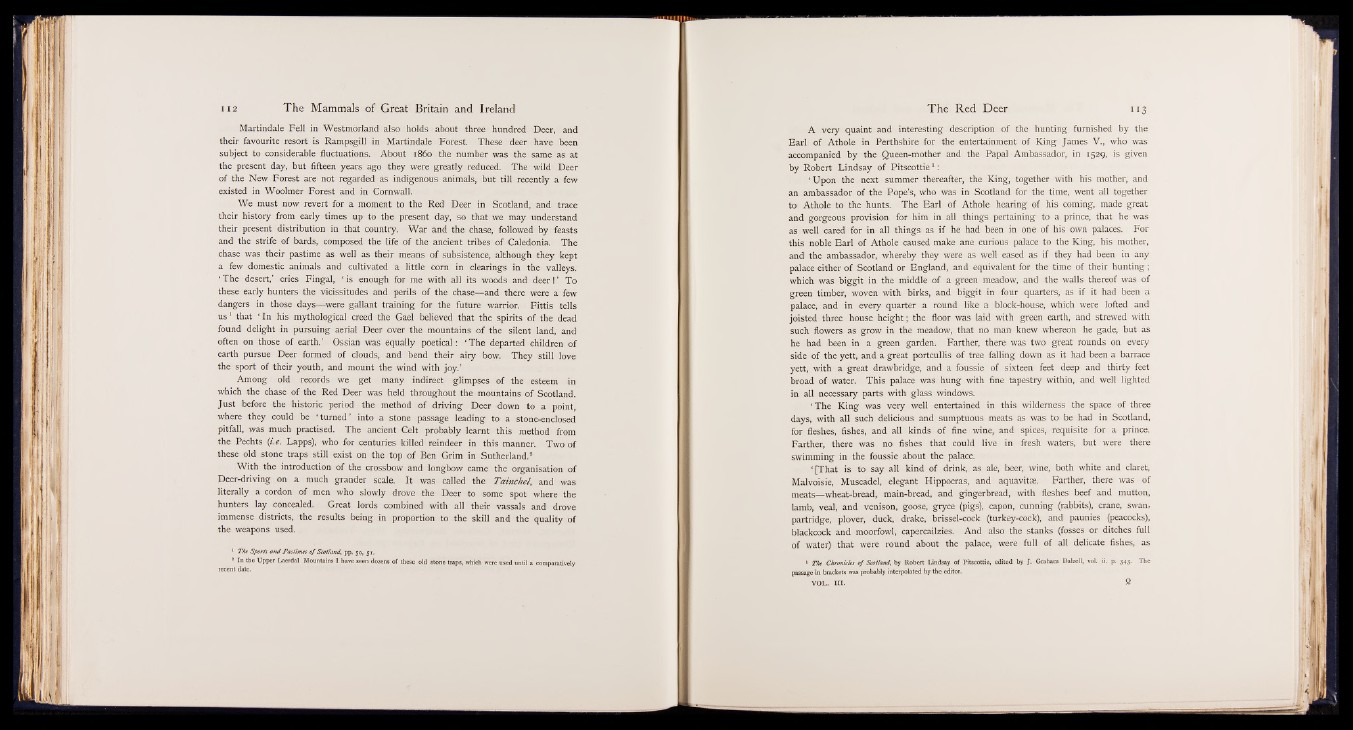
Martindale Fell in Westmorland also holds about three hundred Deer, and
their favourite resort is Rampsgill in Martindale Forest. These deer have been
subject to considerable fluctuations. About i860 the number was the same as at
the present day, but fifteen years ago they were greatly reduced. The wild Deer
of the New Forest are not regarded as indigenous animals, but till recently a few
existed in Woolmer Forest and in Cornwall.
We must now revert for a moment to the Red Deer in Scotland, and trace
their history from early times up to the present day, so that we may understand
their present distribution in that country. War and the chase, followed by feasts
and the strife of bards, composed the life of the ancient tribes of Caledonia. The
chase was their pastime as well as their means of subsistence, although they kept
a few domestic animals and cultivated a little corn in clearings in the valleys.
‘ The desert/ cries Fingal, ‘ is enough for me with all its woods and deer!’ To
these early hunters the vicissitudes and perils of the chase— and there were a few
dangers in those days— were gallant training for the future warrior. Fittis tells
us 1 that ‘ In his mythological creed the Gael believed that the spirits of the dead
found delight in pursuing aerial Deer over the mountains of the silent land, and
often on those of earth.’ Ossian was equally poetical: ‘ The departed children of
earth pursue Deer formed of clouds, and bend their airy bow. They still love
the sport of their youth, and mount the wind with joy.’
Among old records we get many indirect glimpses of the esteem in
which the chase of the Red Deer was held throughout the mountains of Scotland.
Just before the historic period the method of driving Deer down to a point,
where they could be ‘ turned ’ into a stone passage leading to a stone-enclosed
pitfall, was much practised. The ancient Celt probably learnt this method from
the Pechts (i.e. Lapps), who for centuries killed reindeer in this manner. Two of
these old stone traps still exist on the top of Ben Grim in Sutherland.3
With the introduction of the crossbow and longbow came the organisation of
Deer-driving on a much grander scale. It was called the Tainchel, and was
literally a cordon of men who slowly drove the Deer to some spot where the
hunters lay concealed. Great lords combined with all their vassals and drove
immense districts, the results being in proportion to the skill and the quality of
the weapons used.
1 The Sports and Pastimes o f Scotland, pp. 50, 51.
3 In the Upper Laerdal Mountains I have seen dozens of these old stone traps, which were used until a comparatively
recent date.
A very quaint and interesting description of the hunting furnished by the
Earl of Athole in Perthshire for the entertainment of King James V., who was
accompanied by the Queen-mother and the Papal Ambassador, in 1529, is given
by Robert Lindsay of Pitscottie1 :
‘ Upon the next summer thereafter, the King, together with his mother, and
an ambassador of the Pope’s, who was in Scotland for the time, went all together
to Athole to the hunts. The Earl of Athole hearing of his coming, made great
and gorgeous provision for him in all things pertaining to a prince, that he was
as well cared for in all things as if he had been in one of his own palaces. For
this noble Earl of Athole caused make ane curious palace to the King, his mother,
and the ambassador, whereby they were as well eased as if they had been in any
palace either of Scotland or England, and equivalent for the time of their hunting;
which was biggit in the middle of a green meadow, and the walls thereof was of
green timber, woven with birks, and biggit in four quarters, as if it had been a
palace, and in every quarter a round like a block-house, which were lofted and
joisted three house height; the floor was laid with green earth, and strewed with
such flowers as grow in the meadow* that no man knew whereon he gade, but as
he had been in a green garden. Farther, there was two great rounds on every
side of the yett, and a great portcullis of tree falling down as it had been a barrace
yett, with a great drawbridge, and a foussie of sixteen feet deep and thirty feet
broad of water. This palace was hung with fine tapestry within, and well lighted
in all necessary parts with glass windows.
‘ The King was very well entertained in this wilderness the space of three
days, with all such delicious and sumptuous meats as was to be had in Scotland,
for fleshes, fishes, and all kinds of fine wine, and spices, requisite for a prince.
Farther, there was no fishes that could live in fresh waters, but were there
swimming in the foussie about the palace.
‘ [That is to say all kind of drink, as ale, beer, wine, both white and claret,
Malvoisie, Muscadel, elegant Hippocras, and aquavitae. Farther, there was of
meats— wheat-bread, main-bread, and gingerbread, with fleshes beef and mutton,
lamb, veal, and venison, goose, gryce (pigs), capon, cunning (rabbits), crane, swan,
partridge, plover, duck, drake, brissel-cock (turkey-cock), and paunies (peacocks),
blackcock and moorfowl, capercailzies. And also the stanks (fosses or ditches full
of water) that were round about the palace, were full of all delicate fishes, as
1 The Chronicles o f Scotland, by Robert Lindsay of Pitscottie, edited by J. Graham Dalzell, vol. ii. p. 343. The
passage in brackets was probably interpolated by the editor.
VOL. III. Q